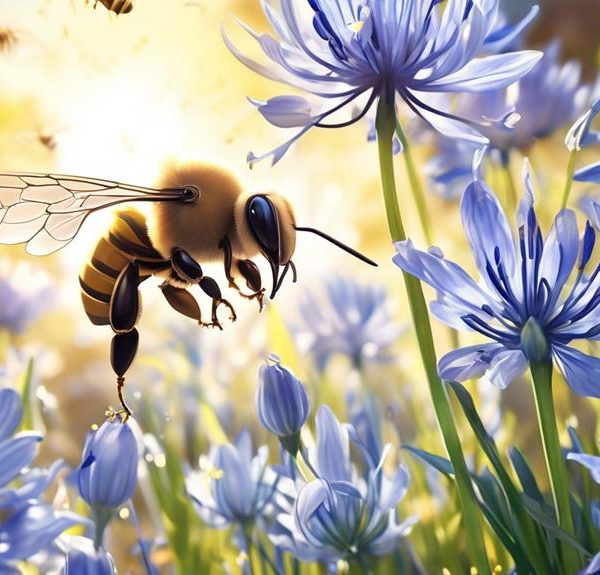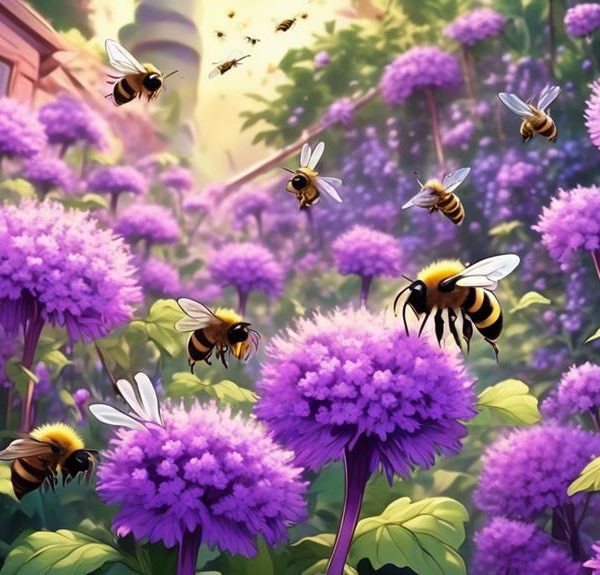Dive into the fascinating world of bees and discover if the vibrant Agastache plant is their preferred nectar source.
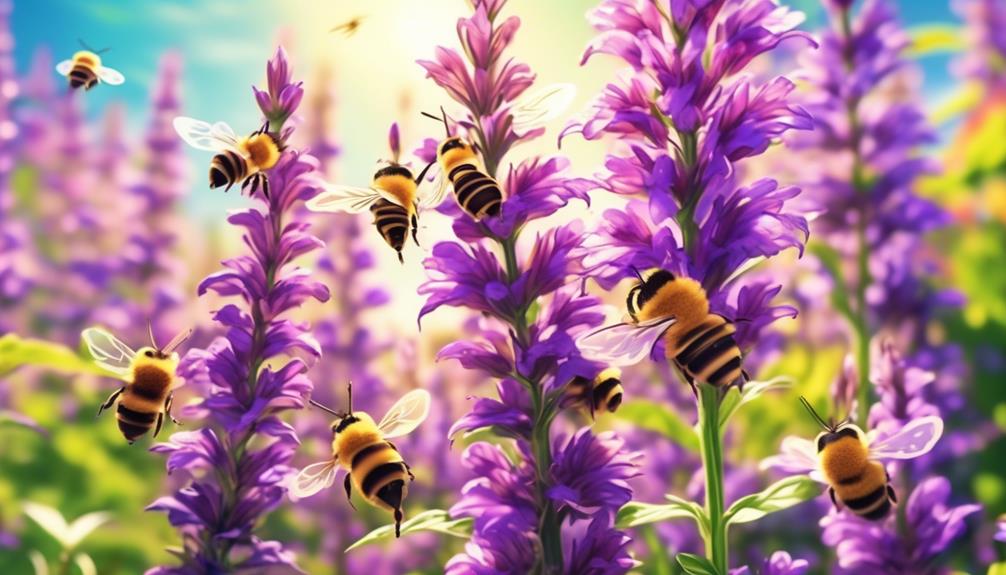
Do Bees Like Agastache?
They say beauty is in the eye of the beholder, and when it comes to bees and Agastache, this old adage might be more accurate than you think.
You're likely wondering if bees are attracted to this specific plant, known for its vibrant colors and aromatic leaves. It's a question that many gardeners and bee enthusiasts grapple with, especially considering the critical role bees play in our ecosystem.
This discussion aims to shed light on this intriguing topic, offering you insights that could transform your understanding of bees and their preferences. So, are bees truly drawn to Agastache or is it a mere fallacy?
Stick around and you'll find out.
Key Takeaways
- Agastache's rich nectar content and vibrant colors attract bees.
- Bees unintentionally transfer pollen while foraging on Agastache, making it an important plant for pollination.
- Agastache provides high nectar production and pollen, which are crucial sources of energy and protein for bees.
- Planting Agastache in gardens can help bolster local bee populations and contribute to the well-being of the ecosystem.
Understanding Agastache's Attraction
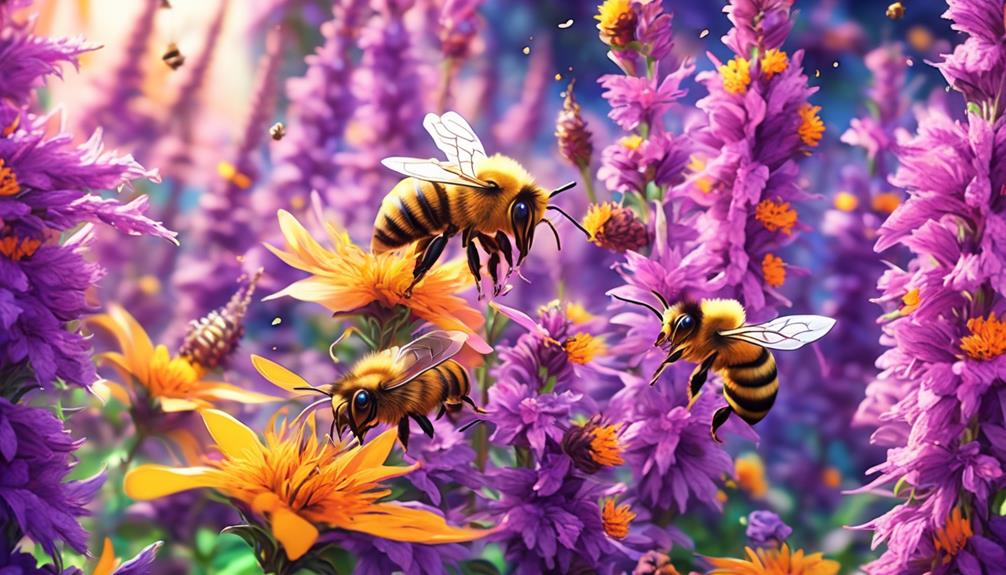
Diving into the allure of the Agastache, you'll find that its rich nectar content and vibrant colors play a significant role in attracting bees. This perennial plant, known for its resilience and hardiness, has an abundance of nectar that's a veritable feast for bees. Its nectar is calorie-rich, providing bees with the energy they need for their daily activities.
The Agastache's vibrant colors aren't merely for show. Bees are drawn to bright colors, and the Agastache's range of hues, from purples to pinks to whites, act as a beacon for bees. Scientific studies have shown that bees can see color faster than humans can, and they tend to gravitate towards plants with bright colors as they're often a sign of a plentiful nectar supply.
Furthermore, Agastache has a prolonged blooming period. This means that it continues to produce nectar for a longer duration than other plants, making it a reliable food source for bees.
The Bee and Agastache Connection
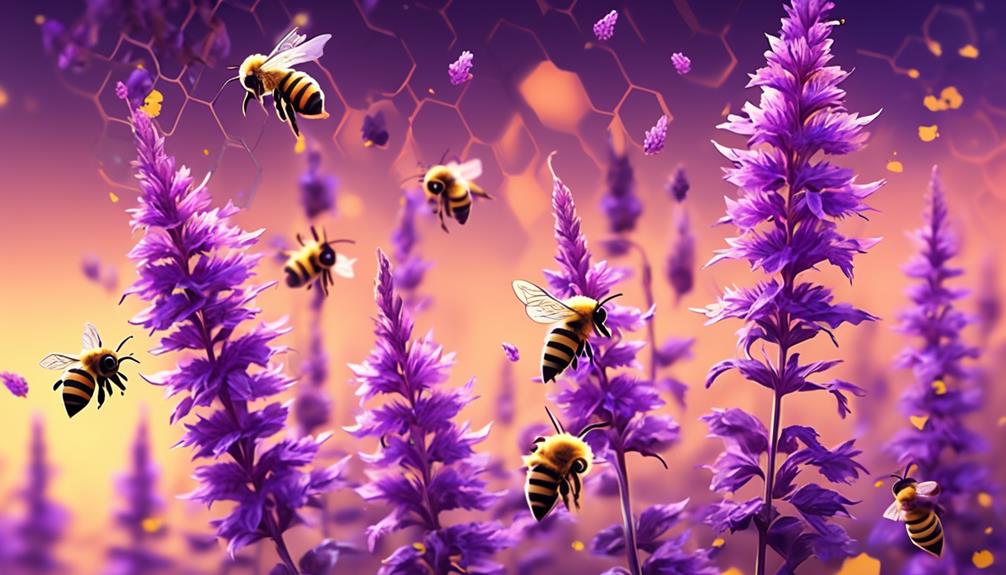
In exploring the relationship between bees and Agastache, it's important to note that this connection isn't one-sided; rather, it's a symbiotic partnership that benefits both parties significantly. As you delve deeper into this relationship, you'll find that bees are attracted to the nectar-rich flowers of the Agastache plant. This provides them with a rich source of food, vital for their survival and productivity.
On the other side of the equation, Agastache relies on bees to perform the crucial task of pollination. In this mutualistic interaction, bees inadvertently transfer pollen from the male anthers to the female stigma of the flowers as they forage, facilitating the reproduction of the plant.
Moreover, Agastache's bright colours and strong scent serve as alluring signals to bees. In turn, the plant's structure, specifically its tubular flowers, are ideally suited for bees' body shape, making nectar extraction easier for them.
Benefits of Agastache for Bees
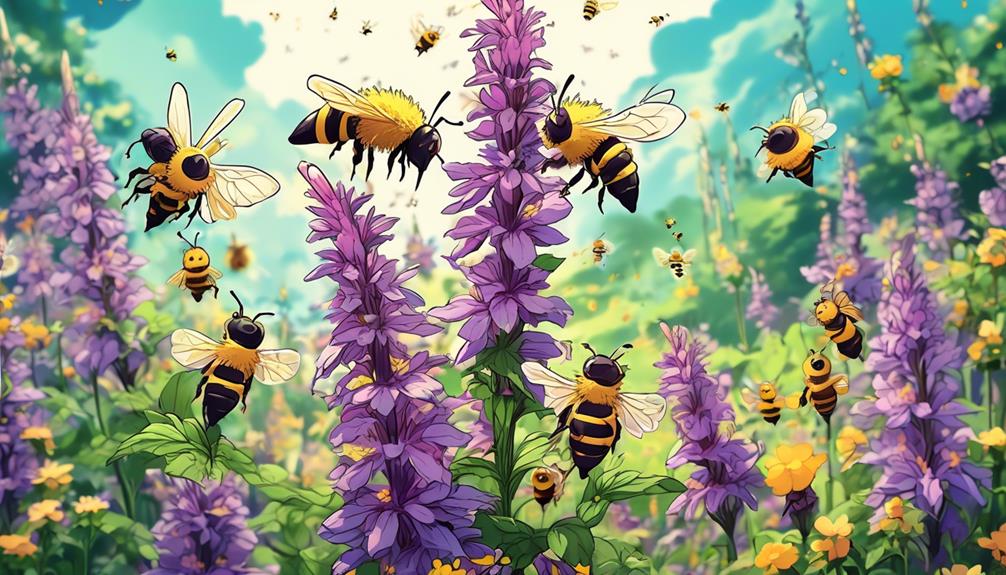
Regularly visiting Agastache plants can offer numerous benefits to bees, enhancing their overall health and survival rates. The Agastache plant, known for its high nectar production, serves as a vital food source for bees, providing them with the energy they need for their daily activities.
But there's more to these plants than just nectar. They're also packed with pollen, a crucial protein source for bees, which can lead to improved bee populations and health. Plus, because Agastache plants bloom for an extended period, they provide a steady source of food for bees, even when other plants aren't in bloom.
To help you visualize the benefits, here's a table:
Benefits | Description | Impact on Bees |
|---|---|---|
High Nectar Production | Provides energy source | Increased activity |
Pollen Source | Provides protein | Improved health |
Long Blooming Period | Ensures steady food source | Enhanced survival rates |
Planting Agastache in Your Garden
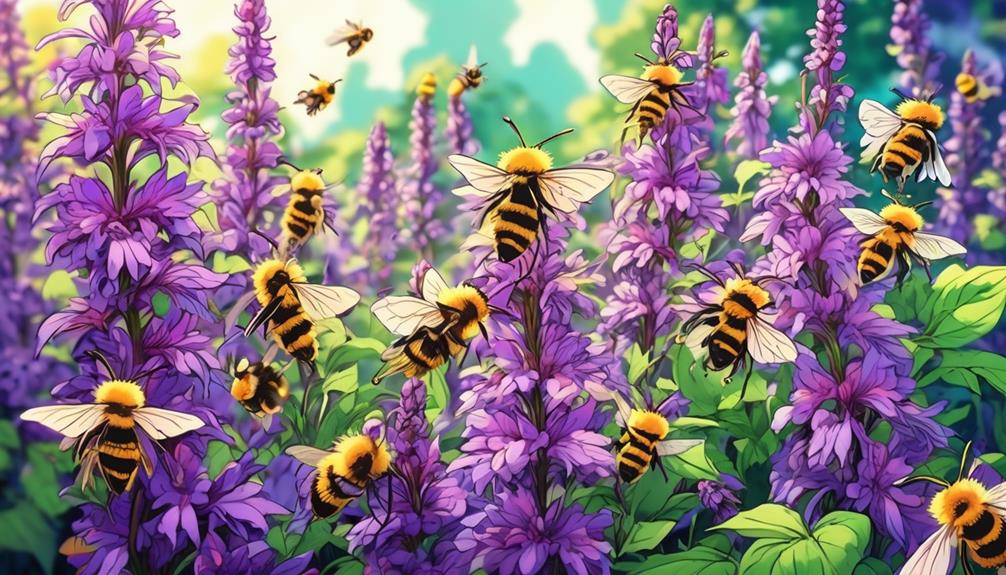
Now that you understand the importance of Agastache for bee health and survival, let's explore how you can effectively plant this beneficial flora in your garden.
Firstly, choose a sunny location. Agastache thrives in full sun, but it can tolerate a bit of afternoon shade. The soil should be well-draining, as waterlogged conditions can lead to root rot. If you've got clay soil, you'll need to amend it with organic matter to improve its drainage capabilities.
When planting, space the plants 18 to 24 inches apart to allow for mature growth. Dig a hole twice as wide as the root ball but not deeper. Set the plant in the hole, ensuring the top of the root ball is level with the ground surface.
After planting, it's crucial to water thoroughly. However, once established, Agastache is surprisingly drought-tolerant, so you won't need to water frequently.
Lastly, Agastache doesn't require heavy fertilization. In fact, too much fertilizer can lead to lush, soft growth that's more susceptible to disease and less appealing to bees. A light application of a balanced, slow-release fertilizer in spring should suffice.
Impact on Local Bee Populations
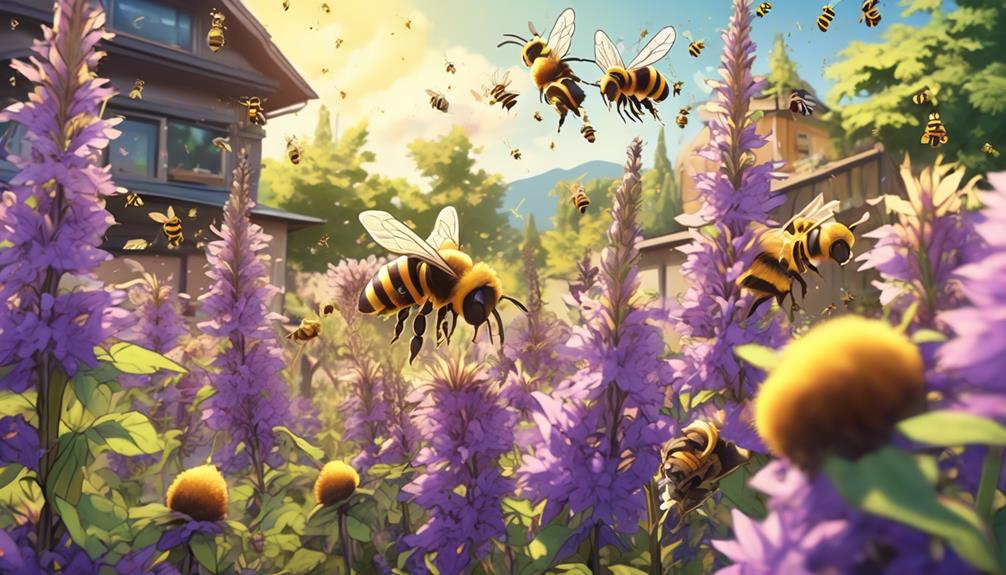
Planting Agastache in your garden can significantly bolster local bee populations, creating a vibrant ecosystem teeming with pollination activity. This perennial plant, rich in nectar, serves as an irresistible buffet for bees. With a continuous supply of food, the bee community thrives, ensuring a healthy reproduction cycle.
To better understand this, let's peer into the table below. It illustrates the impact of Agastache planting on three key factors influencing bee populations.
Factors | Without Agastache | With Agastache |
|---|---|---|
Bee Population | Lower | Higher |
Pollination Activity | Reduced | Boosted |
Reproduction Cycle | Slower | Faster |
With Agastache, you'll notice a rise in the bee population due to enhanced food security. The pollination activity also escalates, resulting in higher crop yields and biodiversity. There's an increase in the reproduction cycle, ensuring a stable bee population.
This is not just about your garden flourishing. It's about contributing to the well-being of the local ecosystem. So, by planting Agastache, you're not just doing your bit for bees, but you're also playing a part in maintaining biodiversity. Now isn't that something to buzz about?
Frequently Asked Questions
What Other Insects Are Attracted to Agastache?
Aside from bees, you'll find a variety of insects attracted to Agastache. Butterflies, hummingbirds, and even some types of beetles can't resist its scent and nectar.
It's also quite popular with various species of moths. However, it doesn't just attract insects, it's a magnet for insect predators too, like praying mantises.
How Can I Prevent Pests From Harming My Agastache Plants?
To prevent pests from harming your Agastache plants, you'll first need to identify the culprits.
Next, consider natural deterrents like neem oil or homemade insecticidal soap.
It's also beneficial to encourage beneficial insects, like ladybugs, that'll prey on the pests.
Regularly check your plants for signs of infestation.
If the problem persists, you might need to use a more potent pesticide, but always remember to follow the manufacturer's instructions to avoid damaging your plants.
Are There Other Plants That Can Attract Bees as Effectively as Agastache?
Yes, there are other plants that can attract bees just as effectively as Agastache.
For instance, plants like Lavender, Coneflowers, and Sunflowers are renowned for their bee-attracting capabilities. You'll often see bees buzzing around these plants, just as they do with Agastache.
It's crucial to choose plants that bloom at different times to provide a consistent food source for bees.
What Are Some Diseases That Agastache Plants Can Suffer From and How Can They Be Treated?
You're asking about diseases that can afflict Agastache plants. They're susceptible to powdery mildew, a fungal disease that appears as a white powder on leaves. It's best controlled by ensuring good air circulation and avoiding overhead watering.
Root rot can also occur in poorly drained soil, so make sure your plants aren't waterlogged. If you notice any signs of these diseases, you'll want to treat them promptly with appropriate fungicides or change your watering habits.
Can Agastache Plants Survive in Different Climates and Soil Conditions?
Yes, you'll find that Agastache plants are quite hardy. They can survive in a range of climates, from USDA zones 5 to 10. They prefer well-drained soil and are drought-resistant once established. However, they don't do well in waterlogged conditions.
For optimal growth, plant them in full sun. Their adaptability to various conditions makes them an excellent choice for diverse landscapes.
Conclusion
So, you see, bees indeed adore Agastache. Its high nectar concentration and vibrant colors act like a magnet, providing essential nutrition for these buzzing pollinators.
By planting Agastache in your garden, you're not just enhancing its beauty, you're also significantly bolstering local bee populations.
Remember, a thriving bee community means a healthier ecosystem.
So, go ahead, let Agastache work its charm and let's give our buzzing buddies a well-deserved boost.

